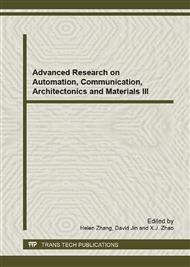[1]
T Uchida, S Ikeda, H Oura, et al. Development of biodegradable scaffolds based on patient-specific arterial configuration. Journal of Biotechnology, 2008, 133 ( 2): 213.
DOI: 10.1016/j.jbiotec.2007.08.017
Google Scholar
[2]
H Hu, G Xu, Q Zan, et al. In situ formation of nano-hydroxyapatite whisker reinforced porous beta-TCP scaffolds. Microelectronic engineering, 2012, 98: 566.
DOI: 10.1016/j.mee.2012.07.001
Google Scholar
[3]
G L Converse, T L Conrad, C H Merrill, et al. Hydroxyapatite whisker-reinforced polyetherketoneketone bone in growth scaffolds. Acta Biomaterialia, 2010, 6( 3); 856.
DOI: 10.1016/j.actbio.2009.08.004
Google Scholar
[4]
H Tabesh, G Amoabediny, N S Nik, et al. The role of biodegradable engineered scaffolds seeded wit Schwann cells for spinal cord regeneration. Neurochemistry International, 2009, 54( 2): 73.
DOI: 10.1016/j.neuint.2008.11.002
Google Scholar
[5]
J Hui, K Buhary A Chowdhary. Implantation of orthobiologic, biodegradable scaffolds in osteochondral repair. Orthopedic Clinics of North America, 2012, 43( 2): 255.
DOI: 10.1016/j.ocl.2012.01.002
Google Scholar
[6]
L F Pettier, R H Jones. Treatment of unicameral bone cysts by curettage and packing with plaster of Paris pellets. Journal of Bone and Joint Surgery, 1978, 60( 6): 820.
DOI: 10.2106/00004623-197860060-00017
Google Scholar
[7]
M H Fathi, A Hanifi, V Mortazavi. Preparation and bioactivity evaluation of bone-like hydroxyapatite nanopowder. Journal of Materials Processing Technology, 2008, 202( 1-3): 536.
DOI: 10.1016/j.jmatprotec.2007.10.004
Google Scholar
[8]
J Vuola, H Goransson, T Bohling, et al. Bone marrow induced osteogenesis in hydroxyapatite and calcium carbonate implants. Biomaterials, 1996, 17( 18): 1761.
DOI: 10.1016/0142-9612(95)00351-7
Google Scholar
[9]
H Yamassaki, H Sakai. Osteogenic response to porous hydroxyapatite ceramics under the skin of dogs. Biomaterials, 1992, 13( 5): 308.
DOI: 10.1016/0142-9612(92)90054-r
Google Scholar
[10]
T Yan, L Tan, D Xiong, et al. Fluoride treatment and in vitro corrosion behavior of an AZ31B magnesium alloy. Materials Science and Engineering: C, 2010, 30( 5): 740.
DOI: 10.1016/j.msec.2010.03.007
Google Scholar


